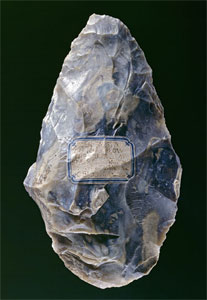Evans the Geologist
|
After becoming headmaster at Market Bosworth, Arthur Benoni Evans had started to take up other interests - collecting fossils and coins - and encouraged his sons Arthur and John to join him. The three Evanses hunted for fossils in the limestone rocks and gravel pits around Bosworth. In 1847 Arthur Benoni's other son George died, leaving him feeling that 'some of the savour had gone out of life and the future was no longer quite so full of interest' (Time and Chance). On impulse he suddenly gave his large collection of fossils to the Leicester Museum. After this early encouragement by his father, John maintained his interest in geology. He continued to look out for stone and flint implements, even on his local walks. Coming home following a different route from church one Sunday he found a 'white worked flint implement with its point broken and came home dreadfully excited' (Time and Chance). |
Although Evans had an interest in geology from an early age, it was probably through his contact with the hydrogeological problems at Dickinson's paper mill that he developed his interests further. John Dickinson and the Grand Junction Canal Company had several legal wrangles over water supply. The canal company regularly took water from the River Gade to supplement the canal, which occasionally leaked. This subsequently reduced the water supply to the mills. Evans's interest in hydrogeology and geology led him to help bridge many of the gaps between the natural sciences and archaeology. He was one of the few, together with Sir Joseph Prestwich (1812-1896) and Jean Albert Gaudry (1827-1908), who laid the foundations of palaeolithic science. He also played an important role in the creation of the anthropology of the Pleistocene epoch. |
|
Evans had met Prestwich, then a wine merchant by profession, when they acted as witnesses for the opposing sides in a lawsuit at Kingston Assizes. They became firm friends and began going on geological expeditions locally. Evans had been admitted as a Fellow of the Geological Society in 1857 and shared Prestwich's researches into the question of the age of gravel drifts and their contents. (Prestwich died in 1896 after fifty years of friendship with Evans and left him to choose 100 books from his collection.) In 1858 Evans and a friend visited Bedford to examine the fossil bones of elephants that had been found in the gravel during the digging of a railway cutting. In 1859 he travelled to Abbeville and joined Prestwich, already there, to see the recent discoveries made by Boucher De Perthes in the gravel pits. Boucher had first discovered worked flint tools in the gravel pits on the Somme in 1847 and had put foward the theory that prehistoric man had existed there at an unprecedentedly early age. Evans and Prestwich authenticated this theory after examining these collections and the early river gravels that produced them. Evans presented a paper on this subject to the Society of Antiquaries in 1860. The expedition to the valley of the Somme encouraged Evans to focus on discovering further traces of prehistoric man both on the Continent and in the British Isles. He collected stone implements from all over the world and in 1872 wrote The Ancient Stone Implements, Weapons and Ornaments, of Great Britain. In 1880 the Geological Society presented him with the Lyell Medal in recognition of his distinguished services to geological science, especially in the department of post-Tertiary geology. |
|
Further References / Links:John Evans, The Ancient Stone Implements, Weapons and Ornaments of Great Britain (1872) Joan Evans, Time and Chance: The Story of Arthur Evans and His Forebears (1943) See also the chapters by Patrick J. Boylan and J.D. Mather in Sir John Evans 1823-1908, edited by Arthur MacGregor (2008) |
|

